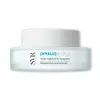What's inside
What's inside
 Key Ingredients
Key Ingredients

 Benefits
Benefits

 Concerns
Concerns

 Ingredients Side-by-side
Ingredients Side-by-side

Snail Secretion Filtrate
Skin ConditioningBetaine
HumectantCaprylic/Capric Triglyceride
MaskingButylene Glycol
HumectantCetearyl Olivate
Sorbitan Olivate
EmulsifyingCetearyl Alcohol
EmollientCarbomer
Emulsion StabilisingEthyl Hexanediol
SolventPhenoxyethanol
PreservativeArginine
MaskingDimethicone
EmollientSodium Polyacrylate
AbsorbentSodium Hyaluronate
HumectantAllantoin
Skin ConditioningPalmitic Acid
EmollientPanthenol
Skin ConditioningXanthan Gum
EmulsifyingStearic Acid
CleansingAdenosine
Skin ConditioningWater
Skin ConditioningMyristic Acid
CleansingSnail Secretion Filtrate, Betaine, Caprylic/Capric Triglyceride, Butylene Glycol, Cetearyl Olivate, Sorbitan Olivate, Cetearyl Alcohol, Carbomer, Ethyl Hexanediol, Phenoxyethanol, Arginine, Dimethicone, Sodium Polyacrylate, Sodium Hyaluronate, Allantoin, Palmitic Acid, Panthenol, Xanthan Gum, Stearic Acid, Adenosine, Water, Myristic Acid
Water
Skin ConditioningButylene Glycol
HumectantGlycerin
HumectantPropylene Glycol
HumectantCaprylic/Capric Triglyceride
MaskingAscorbyl Tetraisopalmitate
Antioxidant1,2-Hexanediol
Skin ConditioningC10-18 Triglycerides
EmollientCarbomer
Emulsion StabilisingMaltodextrin
AbsorbentSodium Hyaluronate
HumectantSodium Acrylates Copolymer
Acrylates/C10-30 Alkyl Acrylate Crosspolymer
Emulsion StabilisingCaprylyl Glycol
EmollientParfum
MaskingSodium Hydroxide
BufferingLecithin
EmollientLactobacillus Ferment
Skin ConditioningPentaerythrityl Tetra-Di-T-Butyl Hydroxyhydrocinnamate
AntioxidantSodium Acetylated Hyaluronate
HumectantWater, Butylene Glycol, Glycerin, Propylene Glycol, Caprylic/Capric Triglyceride, Ascorbyl Tetraisopalmitate, 1,2-Hexanediol, C10-18 Triglycerides, Carbomer, Maltodextrin, Sodium Hyaluronate, Sodium Acrylates Copolymer, Acrylates/C10-30 Alkyl Acrylate Crosspolymer, Caprylyl Glycol, Parfum, Sodium Hydroxide, Lecithin, Lactobacillus Ferment, Pentaerythrityl Tetra-Di-T-Butyl Hydroxyhydrocinnamate, Sodium Acetylated Hyaluronate
 Reviews
Reviews

Ingredients Explained
These ingredients are found in both products.
Ingredients higher up in an ingredient list are typically present in a larger amount.
Butylene Glycol (or BG) is used within cosmetic products for a few different reasons:
Overall, Butylene Glycol is a safe and well-rounded ingredient that works well with other ingredients.
Though this ingredient works well with most skin types, some people with sensitive skin may experience a reaction such as allergic rashes, closed comedones, or itchiness.
Learn more about Butylene GlycolThis ingredient is an emollient, solvent, and texture enhancer. It is considered a skin-softener by helping the skin prevent moisture loss.
It helps thicken a product's formula and makes it easier to spread by dissolving clumping compounds.
Caprylic Triglyceride is made by combining glycerin with coconut oil, forming a clear liquid.
While there is an assumption Caprylic Triglyceride can clog pores due to it being derived from coconut oil, there is no research supporting this.
Learn more about Caprylic/Capric TriglycerideCarbomer is a polymer of acrylic acid. Its main role is to create a gel consistency.
A high amount of carbomer can cause pilling or balling up of products. Don't worry, most products contain 1% or less of carbomer.
Sodium Hyaluronate is hyaluronic acid's salt form. It is commonly derived from the sodium salt of hyaluronic acid.
Like hyaluronic acid, it is great at holding water and acts as a humectant. This makes it a great skin hydrating ingredient.
Sodium Hyaluronate is naturally occurring in our bodies and is mostly found in eye fluid and joints.
These are some other common types of Hyaluronic Acid:
Learn more about Sodium HyaluronateWater. It's the most common cosmetic ingredient of all. You'll usually see it at the top of ingredient lists, meaning that it makes up the largest part of the product.
So why is it so popular? Water most often acts as a solvent - this means that it helps dissolve other ingredients into the formulation.
You'll also recognize water as that liquid we all need to stay alive. If you see this, drink a glass of water. Stay hydrated!
Learn more about Water